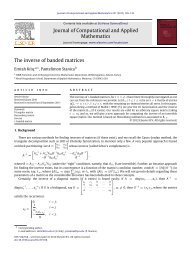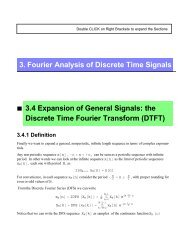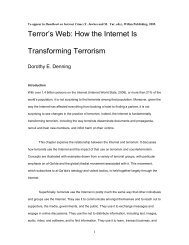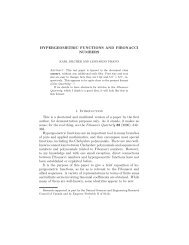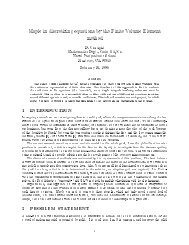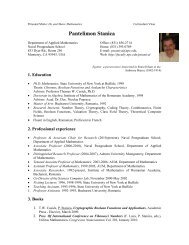Design of an Autonomous Amphibious Robot for Surf - index - Naval ...
Design of an Autonomous Amphibious Robot for Surf - index - Naval ...
Design of an Autonomous Amphibious Robot for Surf - index - Naval ...
You also want an ePaper? Increase the reach of your titles
YUMPU automatically turns print PDFs into web optimized ePapers that Google loves.
Fig. 4. NPS <strong>Autonomous</strong> Vehicle Power Bus [11]<br />
B. S<strong>of</strong>tware<br />
A 500 line C program <strong>an</strong>chors our system <strong>an</strong>d is compiled<br />
to flash ROM on the WILDCAT. Z-World Dynamic C<br />
<strong>of</strong>fers COSTATE capability <strong>an</strong>d is invoked in our program.<br />
COSTATES provide <strong>for</strong> the ability <strong>for</strong> functions to operate<br />
cooperatively during runtime. We found that this helped<br />
optimize our code by allowing functions to give up CPU<br />
cycles while waiting <strong>for</strong> a response or input from internal or<br />
external devices.<br />
The adv<strong>an</strong>tage is that the program uses CPU cycles more<br />
efficiently; the disadv<strong>an</strong>tage is that the programmer loses<br />
some control over function implementation.<br />
Algorithm logic is viewed in Fig. 6 <strong>an</strong>d COSTATE functions<br />
are listed. Any valid sonar contact is serviced as <strong>an</strong><br />
Interrupt Service Routine (ISR) <strong>an</strong>d control is passed to the<br />
Sonar COSTATE. You will notice that the M<strong>an</strong>ual Control<br />
COSTATE overrides all other COSTATES in the algorithm.<br />
C. Communications<br />
The wireless architecture was used <strong>for</strong> three purposes:<br />
1) Pass waypoint data prior to tr<strong>an</strong>sition to autonomous<br />
control<br />
2) Take m<strong>an</strong>ual control<br />
3) Send telemetry (GPS, Compass) <strong>an</strong>d/or error data to<br />
the remote wireless station<br />
Fig. 5. Front View<br />
1467<br />
Fig. 6. Algorithm In<strong>for</strong>mation Flow [9]<br />
Five UDP/IP communications sockets are established <strong>an</strong>d<br />
bound to the ports shown, Fig 6. Ports 4001 <strong>an</strong>d 4002 are set<br />
up one way from the remote station to the <strong>Robot</strong> <strong>an</strong>d ports<br />
4003, 4004 <strong>an</strong>d 4005 from the robot to the remote station.<br />
The UDP protocol is preferred because we do not need a<br />
three-way h<strong>an</strong>dshake <strong>for</strong> communication.<br />
A Java application, “MainApp”, was developed <strong>for</strong> the<br />
remote station, Fig. 7, <strong>for</strong> the user interface. “MainApp”,<br />
displays GPS, waypoint <strong>an</strong>d compass data (on the left), a<br />
field <strong>for</strong> a scaled chart (center), m<strong>an</strong>ual control interface <strong>an</strong>d<br />
a joystick pad (on the right). The scaled chart c<strong>an</strong> be grid<br />
locked to GPS coordinates. There<strong>for</strong>e selection <strong>of</strong> waypoints<br />
is simply a matter <strong>of</strong> double clicking a position on the chart<br />
<strong>an</strong>d sending the waypoint to the <strong>Robot</strong> via the “Send Route”<br />
button.<br />
Fig. 7. Example <strong>of</strong> the Main Application Interface showing the Icons<br />
<strong>for</strong> waypoints in red <strong>an</strong>d the robot in blue. Here we see the robot enroute<br />
waypoint 1 [10]<br />
In Fig. 7 we see the robot en-route waypoint 1. The chart<br />
is a scaled version <strong>of</strong> the NPS quadr<strong>an</strong>gle. Sp<strong>an</strong>agel Hall<br />
is the Science <strong>an</strong>d Engineering Building. You will notice<br />
that parsed GPS <strong>an</strong>d compass data are sent to the remote<br />
station <strong>an</strong>d displayed in the control p<strong>an</strong>el. This gives the<br />
observer a quick view <strong>of</strong> the status <strong>of</strong> the robot while in



